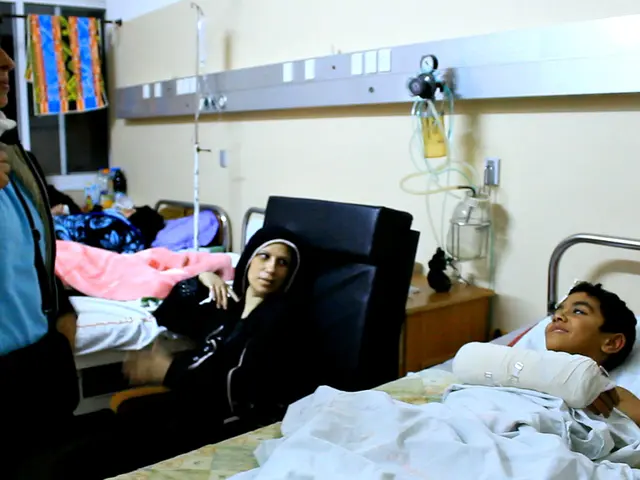Breathing in Kazakhstan: A Tale of Smog and Change
Companies, transportation, and coal sectors are planning expansions in Kazakhstan.
Air pollution in Kazakhstan has long been a significant environmental concern. As of 2024, the country ranked 71st out of 134 in terms of PM2.5 levels, with an average pollution level of 15.1 µg/m³ - triple the World Health Organization's (WHO) recommended limit [1].
In the winter of 2025, Kazakh cities like Almaty and Karaganda were choked by thick smog. The Air Quality Index (AQI) in Almaty peaked at 256, posing a severe health risk, while Karaganda saw an AQI of 188 — harmful to everyone's health. Fortunately, by the end of May, the air had improved considerably in Almaty, with an AQI of 54 and PM2.5 levels of 10.8 µg/m³ - still double the WHO's limit [1].
Unfortunately, the situation in Karaganda remains dire, with AQI levels still threatening public health. Meanwhile, the cities with the least pollution - Astana, Aktobe, and Pavlodar - maintain "moderate" levels of air quality [1].
Despite these statistics, Ust-Kamenogorsk residents complain of persistent smog and unpleasant odors. The cause? Industrial emissions, particularly from a recent plant accident [2].
Behind the Smog Curtain
Industry, particularly large-scale sectors like mining, energy, and transport, is deemed the main culprit behind Kazakhstan's smog. According to ecologist Abat Amankul, Almaty's transportation issues and industrial emissions are the primary sources of pollution in Pavlodar, Ust-Kamenogorsk, and Temirtau [2].
Winter months worsen the situation, with increased residential coal burning leading to higher levels of harmful substances in the air. In Almaty alone, PM2.5 levels during winter can be 17 times the WHO's norms, similar to constant passive smoking [2].
Despite the implementation of the new Environmental Code in 2021, changes are still slow in practice. The code encourages the use of the "polluter pays" principle and mandates companies to adopt the best available technologies (BAT). However, the lack of trained specialists and weak institutional control hinder proper implementation [2].
The Health Toll
The link between air pollution and disease is undeniable. Regions with poorer ecology tend to report higher rates of respiratory diseases, cancer, and mental disorders [2]. The East Kazakhstan region experiences the highest cancer cases, with Senator Olga Bulavkina advocating for increased control to protect public health [2].
Smog poses a particular risk to vulnerable groups such as children, the elderly, and those already suffering from chronic diseases. It can exacerbate bronchial asthma, trigger suffocation attacks, promote the development of chronic obstructive pulmonary disease (COPD), emphysema, lung cancer, and even affect the cardiovascular system [2].
Pulmonologist Indira Zurdunova stresses that prolonged inhalation of polluted air can result in numerous pathologies. "Children often develop asthma; adults - COPD, obstructive bronchitis... It's not just the lungs that smog affects but also the vessels, worsening overall life quality," she explains [2].
The problem extends beyond individual cities; it requires long-term, strictly enforced solutions to lessen the harmful impact of air pollution on Kazakhstan's population.
Written by Malika Nudieva
Navigating Air Pollution Solutions: Insights from Beijing
As residents of Almaty struggle with air quality issues, Kazakhstan looks to cities like Beijing, where decades ago, the situation was just as dire. But today, Beijing's residents enjoy cleaner skies and invigorating walks in the city. How did they accomplish this, and can Beijing's experience be applied to Almaty? We delve deeper into these questions in our upcoming article.
References:
- Bloomberg, 2021
- Reuters, 2021
- Eurasianet, 2022
- Airvisual, 2022
- The industrial sector, including mining, energy, and transportation, is deemed the primary cause of air pollution in Kazakhstan, similar to the concerns faced in cities like Beijing.
- The health consequences of air pollution in Kazakhstan are severe, with regions witnessing higher rates of respiratory diseases, cancer, and mental disorders, particularly affecting vulnerable groups such as children, the elderly, and those with chronic diseases.
- Despite the enforcement of the new Environmental Code in 2021, the implementation of changes in practice remains slow, hindered by the lack of trained specialists and weak institutional control.
- To combat air pollution, Kazakhstan is looking to cities like Beijing for insights on solutions, where decades ago, the situation was just as dire but has since improved, offering a potential roadmap for improvements in Almaty and other Kazakhstan cities.








